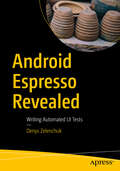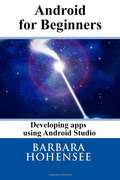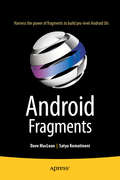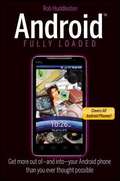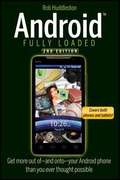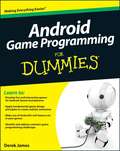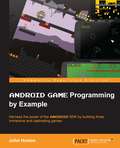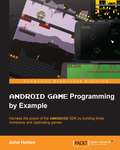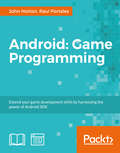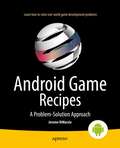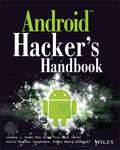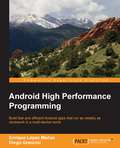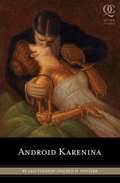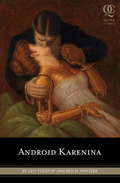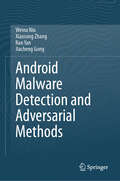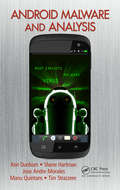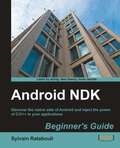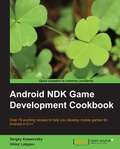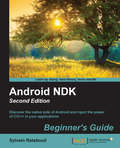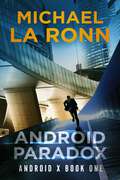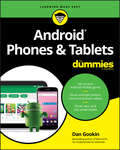- Table View
- List View
Android Espresso Revealed: Writing Automated Ui Tests
by Denys ZelenchukWrite Android user interface (UI) tests using Google Espresso for Android. You’ll cover all the major topics of writing functional UI automated tests using the Espresso testing framework, including different ways of running automated tests, architecting test projects in an easy and maintainable way, and using tools which help to implement automated tests with less effort. Android Espresso Revealed explains the basics of using Espresso to write automated UI tests, and how to customize the framework for advanced functionality. The author provides examples in both Java and Kotlin, and includes dealing with network operations in UI tests, testing application accessibility, implementing supervised monkey tests, and more.
Android For Beginners. Developing Apps Using Android Studio
by Barbara Hohensee Amit Dilip DharmaThe objective of this book is to give an insight into Android programming based on practical App projects. The Apps have different core focuses and hence one can extend and develop them further based on his/her Android knowledge. Thanks to active programming, the users will be quickly acquainted with the work environment and will learn how to solve problems in Android step-by-step. Android Studio, which is a completely new development environment, will be used for programming.
Android For Dummies
by Dan GookinSet up, configure, and get connected Shoot and share photos and videos Use social media, text, and email to stay in touch Make the most of your Android gizmo Be honest—isn't "gizmo" a friendlier word than "device"? This book will tell you pretty much everything you need to know about your Android smartphone or tablet in an equally friendly manner, because that's the best way to learn how to get the most from your Android. From buying, unpacking, and setting up your gizmo to managing calls and email, posting to social media, navigating with Maps, and creating a photo slideshow, it's like having a good friend show you the basics and explain how to take advantage of all the cool stuff. Inside... All about Android 10 Updated security features Customizing your Android Creating multimedia messages Apps to help you get social The Bluetooth connection Exploring Google Play Essential troubleshooting tips
Android Fragments
by Dave Maclean Satya KomatineniAndroid Fragments is a 100-page quick start accelerated guide to learning and quickly using Android fragments. You'll learn how to code for fragments; deal with config changes; code for regular vs. fragmented dialogs; work with preferences and saving state; work with the compatibility library; and handle advanced async tasks and progress dialogs. After reading and using this book, which is based on material from the best-selling Pro Android, you'll be an Android UI savant. At the very least, your apps' user interfaces and event handling will be more competitive and better performing, especially for tablet-optimized UIs and events. What you'll learn What are Android fragments How to work and code for fragments How to respond to configuration changes How to do regular and fragmented dialogs How to work with preferences and saving state How to work with the compatibility library How to handle advanced async tasks and progress dialogs Who this book is for This book is for experienced Android app developers wanting improved user interfaces and their behavior. Table of Contents 1. Fragments Fundamentals 2. Responding to Configuration Changes 3. Dialogs: Regular and Fragment 4. Working with Preferences and Saving State 5. Compatibility Library 6. Advanced Async Task & Progress Dialogs
Android Fully Loaded
by Rob HuddlestonGet all the amazing power your Android smartphone has to offer!The Motorola Droid has quickly become the fastest-selling smartphone, giving the iPhone a run for its money. This little book is packed with big tips for getting more into, and out of, an Android OS phone than ever thought possible. You'll learn to take full advantage of features such as the high-resolution digital camera, GPS, e-mail, Web browsing, location-based mapping, Google Calendar and Google Docs, hundreds of readily available apps, and tricks such as scanning a barcode to get product reviews or translating foreign signs. Motorola Droid sales are booming, fueled by the Android OS's amazing versatility and open access to appsThis book shows how to put anything on an Android phone: old movies, TV shows, music, spreadsheets, presentations, Word documents, and much moreCovers all the basic features such as Web browsing, using Facebook and Twitter, taking photos, playing music, and using e-mailOffers dozens of high-level tips and tricks for maximizing turn-by-turn navigation, using an Android as a broadband modem, scanning a barcode to access product reviews and comparing prices, syncing with Google services, and photographing objects for Google to identifyAndroid Fully Loaded enables you to take maximum advantage of your Android OS smartphone.
Android Fully Loaded, Second Edition
by Rob HuddlestonFully loaded with the latest tricks and tips on your new Android! Android smartphones are so hot, they're soaring past iPhones on the sales charts. And the second edition of this muscular little book is equally impressive--it's packed with tips and tricks for getting the very most out of your latest-generation Android device. Start Facebooking and tweeting with your Android mobile, scan barcodes to get pricing and product reviews, download your favorite TV shows--the book is positively bursting with practical and fun how-tos. Topics run the gamut from using speech recognition, location-based mapping, and GPS, to setting up your Android as a broadband modem and much more. Helps you get the most out of your Android smartphone and related technology, including Motorola Droid 2, Motorola Photon 4G, HTC Thunderbolt, LG Optimus 3D, and HTC EVO 3D Shows you how to put a slew of stuff on your Android: old movies, TV shows, music, spreadsheets, presentations, Word documents, and much more Covers all the basic features such as web browsing, using Facebook and Twitter, taking photos, playing music, and using e-mail Offers dozens of high-level tips and tricks, such as using an Android as a broadband modem, barcode scanning, using the GPS, and speech recognition You won't believe all that you can do with Android smartphones. Get Android Fully Loaded, Second Edition and don't miss a thing!
Android Game Programming For Dummies
by Derek JamesLearn how to create great games for Android phonesAndroid phones are rapidly gaining market share, nudging the iPhone out of the top spot. Games are the most frequently downloaded apps in the Android market, and users are willing to pay for them. Game programming can be challenging, but this step-by-step guide explains the process in easily understood terms. A companion Web site offers all the programming examples for download.Presents tricky game programming topics--animation, battery conservation, touch screen input, and adaptive interface issues--in the straightforward, easy-to-follow For Dummies fashionExplains how to avoid pitfalls and create fun games based on best programming practices for mobile devicesA companion web site includes all programming examplesIf you have some programming knowledge, Android Game Programming For Dummies will have you creating cool games for the Android platform quickly and easily.
Android Game Programming by Example
by John HortonThe book is best suited for existing Android or Java programmers who want to adapt their skills to make exciting Android games. The book is also for determined readers who might have no Android, game programming or even Java experience, but a reasonable understanding of object oriented programming knowledge is assumed.
Android Game Programming by Example
by John Horton<P><P>Harness the power of the Android SDK by building three immersive and captivating games <P><P>About This Book <P><P>Implement the critical main game loop and structure your games to enable an array of advanced features <P><P>Animate your characters with sprite sheets, add multiple scrolling parallax backgrounds, and implement genuinely tough, playable levels in your games <P><P>Build super-smooth 60 frames per second with the help of this easy-to-follow, projects-based guide <P><P>Who This Book Is For <P><P>The book is best suited for existing Android or Java programmers who want to adapt their skills to make exciting Android games. <P><P>The book is also for determined readers who might have no Android, game programming or even Java experience, but a reasonable understanding of object oriented programming knowledge is assumed. <P><P>What You Will Learn <P><P>Build simple to advanced game engines for different types of game, with cool features such as sprite sheet character animation and scrolling parallax backgrounds <P><P>Design and implement genuinely challenging and playable levels <P><P>Implement the critical main game loop <P><P>Implement basic and advanced collision detection mechanics <P><P>Bring to life a challenging enemy AI <P><P>Make the math behind 2D rotation, velocity, and collisions simple <P><P>Run your game designs at 60 frames per second or better <P><P>Process multitouch screen input effectively and efficiently <P><P>Implement a multitude of other game features such as pickups, firing weapons, HUDs, generating and playing sound FX, scenery, level transition, high scores, and more <P><P>Implement a flexible and advanced game engine that uses OpenGL ES 2 for fast, smooth frame rates In Detail <P><P>Android gaming is a hot topic these days, but one of the few areas of technology that does not have an abundance of clear and useful documentation online. However, there is an ever-increasing demand for Android games. <P><P>This book will help you get up to speed with the essentials of game development with Android. The book begins by teaching you the setup of a game development environment on a fundamental level. Moving on, the book deals with concepts such as building a home screen UI, implementing game objects, and painting the scene at a fixed resolution. Gradually, it builds up to the implementation of a flexible and advanced game engine that uses OpenGL ES 2 for fast, smooth frame rates. This is achieved by starting with a simple game and gradually increasing the complexity of the three complete games built step by step. By the end of the book, you will have successfully built three exciting games over the course of three engrossing and insightful projects.
Android Game Programming: A Developer's Guide
by John Horton Raul PortalesExtend your game development skills by harnessing the power of Android SDK About This Book * Gain the knowledge to design and build highly interactive and amazing games for your phone and tablet from scratch * Create games that run at super-smooth 60 frames per second with the help of these easy-to-follow projects * Understand the internals of a game engine by building one and seeing the reasoning behind each of the components Who This Book Is For If you are completely new to Java, Android, or game programming, this book is for you. If you want to publish Android games for fun or for business and are not sure where to start, then this book will show you what to do, step by step, from the start. What You Will Learn * Set up an efficient, professional game development environment in Android Studio * Explore object-oriented programming (OOP) and design scalable, reliable, and well-written Java games or apps on almost any Android device * Build simple to advanced game engines for different types of game, with cool features such as sprite sheet character animation and scrolling parallax backgrounds * Implement basic and advanced collision detection mechanics * Process multitouch screen input effectively and efficiently * Implement a flexible and advanced game engine that uses OpenGL ES 2 to ensure fast, smooth frame rates * Use animations and particle systems to provide a rich experience * Create beautiful, responsive, and reusable UIs by taking advantage of the Android SDK * Integrate Google Play Services to provide achievements and leaderboards to the players In Detail Gaming has historically been a strong driver of technology, whether we're talking about hardware or software performance, the variety of input methods, or graphics support, and the Android game platform is no different. Android is a mature, yet still growing, platform that many game developers have embraced as it provides tools, APIs, and services to help bootstrap Android projects and ensure their success, many of which are specially designed to help game developers. Since Android uses one of the most popular programming languages, Java, as the primary language to build apps of all types, you will start this course by first obtaining a solid grasp of the Java language and its foundation APIs. This will improve your chances of succeeding as an Android app developer. We will show you how to get your Android development environment set up and you will soon have your first working game. The course covers all the aspects of game development through various engrossing and insightful game projects. You will learn all about frame-by-frame animations and resource animations using a space shooter game, create beautiful and responsive menus and dialogs, and explore the different options to play sound effects and music in Android. You will also learn the basics of creating a particle system and will see how to use the Leonids library. By the end of the course, you will be able to configure and use Google Play Services on the developer console and port your game to the big screen. This Learning Path combines some of the best that Packt has to offer in one complete, curated package. It includes content from the following Packt products: * Learning Java by Building Android Games by John Horton * Android Game Programming by Example by John Horton * Mastering Android Game Development by Raul Portales Style and approach This course is a step-by-step guide where you will learn to build Android games from scratch. It takes a practical approach where each project is a game. It starts off with simple arcade games, and then gradually the complexity of the games keep on increasing as you uncover the new and advanced tools that Android offers.
Android Game Recipes: A Problem-Solution Approach
by J. F. DimarzioAndroid game apps are typically the most popular type of Android apps in the various Google Play, Amazon Appstore and other Android app stores. So, beyond the Android game tutorials out there, what about a day-to-day handy and complete code reference for Android game developers? Android Game Recipes is your first, reliable game coding reference for today's Android game apps. This book provides easy to follow real world game code problems and solutions, including source code. This book covers code recipe solutions that are common to 2D game development problems such as designing a game menu, collision detection, moving characters, moving backgrounds and more. This book also includes how to work with player input, how to add multiple levels, how to create game graphics for different screen resolution, and how to work with device sensors. After reading and using this book, you'll have the templated code snippets, solutions and frameworks to apply to your game app design to build your game, customize it, and then sell it on the Android app stores.
Android Hacker's Handbook
by Collin Mulliner Georg Wicherski Pau Oliva Fora Joshua J. Drake Zach Lanier Stephen A. RidleyThe first comprehensive guide to discovering and preventingattacks on the Android OSAs the Android operating system continues to increase its shareof the smartphone market, smartphone hacking remains a growingthreat. Written by experts who rank among the world's foremostAndroid security researchers, this book presents vulnerabilitydiscovery, analysis, and exploitation tools for the good guys.Following a detailed explanation of how the Android OS works andits overall security architecture, the authors examine howvulnerabilities can be discovered and exploits developed forvarious system components, preparing you to defend againstthem.If you are a mobile device administrator, security researcher,Android app developer, or consultant responsible for evaluatingAndroid security, you will find this guide is essential to yourtoolbox.A crack team of leading Android security researchers explainAndroid security risks, security design and architecture, rooting,fuzz testing, and vulnerability analysisCovers Android application building blocks and security as wellas debugging and auditing Android appsPrepares mobile device administrators, security researchers,Android app developers, and security consultants to defend Androidsystems against attackAndroid Hacker's Handbook is the first comprehensiveresource for IT professionals charged with smartphonesecurity.
Android High Performance Programming
by Diego Grancini Enrique Lopez ManasBuild fast and efficient Android apps that run as reliably as clockwork in a multi-device world About This Book * Wide coverage of various topics that help in developing optimal applications * Explore the concepts of Advanced Native Coding in depth * A must-have for professional-standard Android developers for whom performance failures and the sloppy use of resources are simply unacceptable Who This Book Is For This book is aimed at developers with an advanced knowledge of Android and who want to test their skills and learn new techniques to increase the performance of their applications. We assume they are comfortable working with the entire Android SDK, and have been doing it for a few years. They need to be familiar with frameworks such as NDK to use native code, which is crucial for app performance What You Will Learn * Create Android applications that squeeze the most from the limited resource capacity of devices * Swap code that isn't performing * Efficient memory management by identifying problems such as leaks * Reap the benefits of multithreaded and asynchronous programming * Maximize the security and encryption mechanisms natively provided by Android * Perform efficient network operations and techniques to retrieve data from servers * Master the NDK to write native code that can perform faster operations In Detail Performant applications are one of the key drivers of success in the mobile world. Users may abandon an app if it runs slowly. Learning how to build applications that balance speed and performance with functionality and UX can be a challenge; however, it's now more important than ever to get that balance right. Android High Performance will start you thinking about how to wring the most from any hardware your app is installed on, so you can increase your reach and engagement. The book begins by providing an introduction to state-of-the-art Android techniques and the importance of performance in an Android application. Then, we will explain the Android SDK tools regularly used to debug and profile Android applications. We will also learn about some advanced topics such as building layouts, multithreading, networking, and security. Battery life is one of the biggest bottlenecks in applications; and this book will show typical examples of code that exhausts battery life, how to prevent this, and how to measure battery consumption from an application in every kind of situation to ensure your apps don't drain more than they should. This book explains techniques for building optimized and efficient systems that do not drain the battery, cause memory leaks, or slow down with time. Style and approach The book follows a tutorial-based approach to take the reader from the basic fundamentals of debugging to advanced performance-improvement concepts.
Android Karenina
by Leo Tolstoy Ben H. Winters"Sense and Sensibility and Sea Monsters" co-author Winters is back with an all-new collaborator, legendary Russian novelist Tolstoy, and the result is an enhanced edition of the classic love story set in a dystopian world of robots, cyborgs, and interstellar space travel.
Android Karenina
by Constance Garnett Leo Tolstoy Eugene Smith Ben WintersIt's been called the greatest novel ever written. Now, Tolstoy's timeless saga of love and betrayal is transported to an awesomer version of 19th-century Russia. It is a world humming with high-powered groznium engines: where debutantes dance the 3D waltz in midair, mechanical wolves charge into battle alongside brave young soldiers, and robots--miraculous, beloved robots!--are the faithful companions of everyone who's anyone. Restless to forge her own destiny in this fantastic modern life, the bold noblewoman Anna and her enigmatic Android Karenina abandon a loveless marriage to seize passion with the daring, handsome Count Vronsky. But when their scandalous affair gets mixed up with dangerous futuristic villainy, the ensuing chaos threatens to rip apart their lives, their families, and--just maybe--all of planet Earth.From the Trade Paperback edition.
Android Malware (SpringerBriefs in Computer Science)
by Xuxian Jiang Yajin ZhouMobile devices, such as smart phones, have achieved computing and networking capabilities comparable to traditional personal computers. Their successful consumerization has also become a source of pain for adopting users and organizations. In particular, the widespread presence of information-stealing applications and other types of mobile malware raises substantial security and privacy concerns. Android Malware presents a systematic view on state-of-the-art mobile malware that targets the popular Android mobile platform. Covering key topics like the Android malware history, malware behavior and classification, as well as, possible defense techniques.
Android Malware Detection and Adversarial Methods
by Xiaosong Zhang Weina Niu Ran Yan Jiacheng GongThe rise of Android malware poses a significant threat to users’ information security and privacy. Malicious software can inflict severe harm on users by employing various tactics, including deception, personal information theft, and device control. To address this issue, both academia and industry are continually engaged in research and development efforts focused on detecting and countering Android malware. This book is a comprehensive academic monograph crafted against this backdrop. The publication meticulously explores the background, methods, adversarial approaches, and future trends related to Android malware. It is organized into four parts: the overview of Android malware detection, the general Android malware detection method, the adversarial method for Android malware detection, and the future trends of Android malware detection. Within these sections, the book elucidates associated issues, principles, and highlights notable research. By engaging with this book, readers will gain not only a global perspective on Android malware detection and adversarial methods but also a detailed understanding of the taxonomy and general methods outlined in each part. The publication illustrates both the overarching model and representative academic work, facilitating a profound comprehension of Android malware detection.
Android Malware Detection using Machine Learning: Data-Driven Fingerprinting and Threat Intelligence (Advances in Information Security #86)
by Mourad Debbabi Djedjiga Mouheb ElMouatez Billah Karbab Abdelouahid DerhabThe authors develop a malware fingerprinting framework to cover accurate android malware detection and family attribution in this book. The authors emphasize the following: (1) the scalability over a large malware corpus; (2) the resiliency to common obfuscation techniques; (3) the portability over different platforms and architectures.First, the authors propose an approximate fingerprinting technique for android packaging that captures the underlying static structure of the android applications in the context of bulk and offline detection at the app-market level. This book proposes a malware clustering framework to perform malware clustering by building and partitioning the similarity network of malicious applications on top of this fingerprinting technique. Second, the authors propose an approximate fingerprinting technique that leverages dynamic analysis and natural language processing techniques to generate Android malware behavior reports. Based on this fingerprinting technique, the authors propose a portable malware detection framework employing machine learning classification. Third, the authors design an automatic framework to produce intelligence about the underlying malicious cyber-infrastructures of Android malware. The authors then leverage graph analysis techniques to generate relevant intelligence to identify the threat effects of malicious Internet activity associated with android malware.The authors elaborate on an effective android malware detection system, in the online detection context at the mobile device level. It is suitable for deployment on mobile devices, using machine learning classification on method call sequences. Also, it is resilient to common code obfuscation techniques and adaptive to operating systems and malware change overtime, using natural language processing and deep learning techniques.Researchers working in mobile and network security, machine learning and pattern recognition will find this book useful as a reference. Advanced-level students studying computer science within these topic areas will purchase this book as well.
Android Malware and Analysis
by Ken Dunham Shane Hartman Manu Quintans Jose Andre Morales Tim StrazzereThe rapid growth and development of Android-based devices has resulted in a wealth of sensitive information on mobile devices that offer minimal malware protection. This has created an immediate need for security professionals that understand how to best approach the subject of Android malware threats and analysis.In Android Malware and Analysis, K
Android NDK Beginner’s Guide
by Sylvain RatabouilThis beginner's guide focuses on getting you through all the major learning points in a smooth, logical order. You'll also see how to avoid some common pitfalls. Are you an Android Java programmer who needs more performance? Are you a C/C++ developer who doesn't want to bother with Java stuff and its out-of-control garbage collector? Do you want to create fast intensive multimedia applications or games? Answer yes to any of the above and this book is for you. With some general knowledge of C/C++ development, you will be able to dive head first into native Android development.
Android NDK Game Development Cookbook
by Viktor Latypov Sergey KosarevskyA systematic guide consisting of over 70 recipes which focus on helping you build portable mobile games and aims to enhance your game development skills with clear instructions.If you are a C++ developer who wants to jump into the world of Android game development and who wants to use the power of existing C++ libraries in your existing Android Java applications, then this book is for you. You need to have basic knowledge of C or C++ including pointer manipulation, multithreading, and object-oriented programming concepts as well as some experience developing applications without using an IDE.
Android NDK: Beginner's Guide - Second Edition
by Sylvain RatabouilThis book is intended for those who are interested in learning the core features of the Spring Framework. Prior knowledge of Java programming and web development concepts with basic XML knowledge is expected.
Android Native Development Kit Cookbook
by Feipeng LiuThis book is written in a Cookbook style, beginning with recipes which focus on helping developers make their software/application available in Android.Android developers who want to learn Android NDK programming, or develop multimedia and games in Android NDK will benefit from this book
Android Paradox (Android X #1)
by Michael La RonnThe future belongs to humans and androids...or is that a paradox? The year is 2300. Humans and androids live in peace after a devastating singularity and years of war. Xandifer "X" Crenshaw is an android special agent who hunts down rogue androids and dismantles them. No one evades him for very long. When a fellow android agent goes maverick and starts a killing spree, this time it's personal. And if X doesn't disable his foe swiftly and silently before the press finds out, it will shatter the alliance between humans and androids forever. X and his human partner, Shortcut won't rest until this mission is complete---unless they end up dead first.If you love science fiction thrillers, then grab your copy of Android Paradox today! V2.0
Android Phones & Tablets For Dummies
by Dan GookinOutsmart your new Android Getting a smartphone or tablet can be intimidating for anyone, but this user-friendly guide is here to help you to get the most out of all your new gadget has to offer! Whether you’re upgrading from an older model or totally new to the awesome world of Androids, this book makes it easier than ever to get up and running with the latest technology. From setup and configuration to taking advantage of all those intricate bells and whistles, Android Phones & Tablets For Dummies helps you unleash everything your Android can do for you. If you’re looking to use your phone or tablet for texting, emailing, accessing the Internet, or anything in between, you’ll want to keep this go-to reference close by every step of the way. • Make sense of the phone features • Find your way around with navigation • Capture moments on the camera • Seamlessly sync with a PC or Mac Who needs a headache when dealing with a new device? This book makes it totally pain free!
